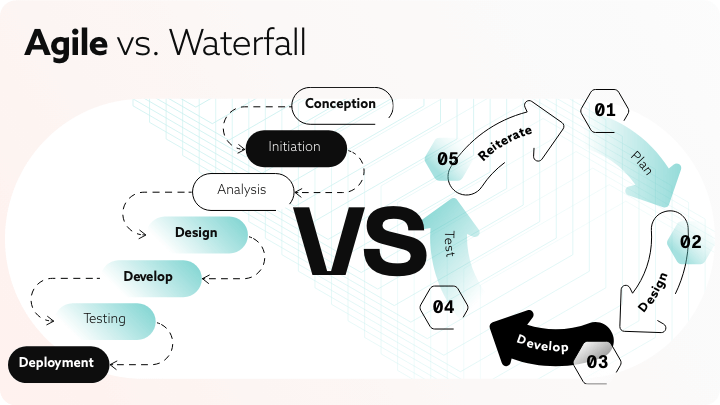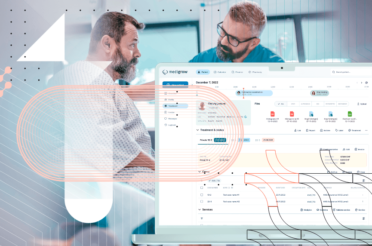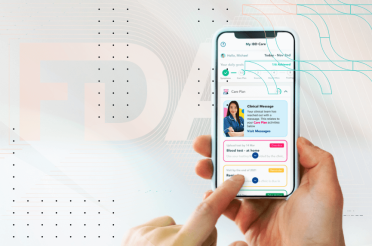Software development can often be exhausting and time-consuming, especially in the healthcare sector, where strict regulations must be followed alongside meeting customer requirements.
Several approaches aim to simplify and streamline this process. One of the most popular methods is the Agile development process, which helps ensure both technical excellence and continuous delivery.
In recent years, software development teams have increasingly adopted the Agile methodology, with usage rising from 37% in 2020 to 86% in 2021. [1] One of the primary goals of any methodology is to deliver functional software, and Agile excels in this area.
To fully understand how Agile meets business needs, it’s important to first grasp its key features and how it differs from other approaches.
Overview of Agile Software Development
Many software developers believe that Agile is simply a mix of best practices and tools. However, Agile is a comprehensive methodology that emphasizes customer satisfaction, flexibility, and collaboration. It integrates several “good practices” that complement each other to create a cohesive process.
These practices include:
- Test-driven development;
- Daily meetings;
- Two-person programming;
- Iterations (sprints);
- Sprint planning.
Agile uses several frameworks, such as Extreme Programming, FDD, Scrum, and Kanban, to implement its practices. These frameworks reflect components of the Agile manifesto, promoting early and continuous delivery. They can be applied individually or combined across multiple projects.
Agile breaks large software projects into smaller, manageable units called sprints or iterations, which typically last one to four weeks. Agile’s core values push teams to deliver working software frequently. It also offers a more dynamic approach to systems development and provides greater flexibility throughout the project.
The main potential challenge for Agile is the shift it requires in how development teams approach projects. Traditionally, software projects are developed as complete units, but Agile focuses on delivering individual components before the entire application is finished.
Agile methodology’s guiding principles
According to the Agile Alliance, the methodology’s ability to produce valuable software, ensure iterative development, and support continuous improvement is guided by 12 key principles. [2] To understand why the Agile delivery process is effective, it is important to explore each of these principles in detail.
1. Customer satisfaction through early and continuous delivery
Early and frequent delivery of valuable software ensures visible progress and timely customer feedback, thus keeping customer needs a top priority. This approach helps teams gain a deeper understanding of client expectations and product development.
By consistently delivering smaller, functional pieces of software, Agile practices build trust and maintain customer satisfaction throughout the development process.
2. Embrace changing requirements
Change is inevitable in Agile development, especially for complex projects. Agile teams embrace requirement changes, even late in the process, which allows them to adapt to evolving market conditions and customer needs.
This flexibility ensures the product remains valuable and relevant throughout its development.
3. Working software is delivered frequently.
Regular delivery of working software, typically every few weeks to two months, ensures steady progress and early problem detection.
This iterative approach allows teams to make swift adjustments based on frequent customer feedback. It helps maintain momentum while continuously demonstrating value to stakeholders.
4. Developers and business stakeholders working together
Collaboration is central to Agile project management, and daily meetings play a key role in ensuring it. These meetings bring developers and business stakeholders together to foster a shared understanding of priorities and goals.
Close collaboration allows the development team to quickly address changes or challenges and keep the focus on business objectives. Effective communication and teamwork lead to better decision-making and a product that more closely aligns with business needs.
5. Motivated individuals
People are the foundation of any project, and agile projects thrive on the energy and dedication of motivated individuals.
To attract and retain such talent, project management frameworks must provide:
- A supportive environment,
- Adequate resources,
- Trust.
These factors empower team members to perform at their best. When individuals feel valued and motivated, they are more likely to take initiative and contribute meaningfully to the project’s success.
6. In-person communication
In-person interactions play a vital role in an Agile team. They are considered the most effective way to share information.
Direct communication strengthens team relationships, accelerates decision-making, and reduces misunderstandings. It fosters a collaborative environment where team members can easily exchange ideas and quickly address issues.
7. Functional software as the main indicator of development
In any project, the outcome is what matters. Agile teams assess their progress by delivering working software.
Unlike traditional methods that focus on documentation or compliance, Agile prioritizes functional software as the true indicator of progress. This focus ensures the team is consistently working to deliver measurable business value to the client.
8. Sustainable development
For any methodology to endure, it must consider sustainability. Agile promotes a pace the team can maintain indefinitely, fostering long-term productivity and well-being while preventing burnout.
A team that can only complete part of the project is inefficient. Sustainable development practices lead to higher-quality work and a more resilient team, especially in the software industry.
9. Technical proficiency and thoughtful design
Another key principle of the Agile process is the continuous focus on technical excellence and good design, which helps maintain agility.
Prioritizing best practices in coding and design allows agile teams to build software that is both resilient and adaptable. By ensuring high quality, they reduce technical debt and make maintenance and future development smoother.
10. Simplicity
Although software development can appear complex, simplicity is among the core Agile values.
In Agile, simplicity means delivering only what is necessary and valuable and reducing unnecessary work. This principle streamlines the development process by helping teams avoid unnecessary features and complications. By focusing on simplicity, teams can create more efficient solutions faster and with fewer resources.
11. Self-organizing teams
Managing any team can be challenging, but Agile follows a unique approach by embracing self-organizing teams. This structure allows teams the freedom to determine the best way to accomplish their tasks.
With this empowerment, team members are encouraged to uphold three key values:
- Creativity,
- Responsibility,
- Ownership.
Self-organizing teams are often more creative and productive, as they can quickly adapt to challenges and changes.
12. Regular reflection and adjustment
Agile teams regularly assess their operations and performance to identify areas for improvement. This cycle of continuous improvement, often facilitated by retrospectives, ensures that teams are always refining their processes and enhancing their skills.
By consistently adjusting their behavior, Agile teams maintain high performance and adaptability.
Frameworks for agile software development
Agile’s effectiveness largely stems from its frameworks, which provide structured ways to apply Agile principles.
Scrum
One of the most widely used frameworks is Scrum, which supports iterative progress and incremental development through 2- to 4-week sprints. The key roles within the Scrum framework are a Scrum Master, a Product Owner, and a Development Team.
Scrum also incorporates Agile practices such as sprint planning, daily stand-ups, sprint reviews, and retrospectives to guide and optimize the development process.
Kanban
Kanban is another popular Agile framework that focuses on limiting work in progress and visualizing the workflow using columns like “To Do,” “In Progress,” and “Done.” By making small adjustments, teams can identify and resolve bottlenecks to improve efficiency.
Extreme Programming (XP) is typically used in projects requiring high-quality code and rapid iterations, while Kanban is favored in environments that emphasize workflow optimization. XP stresses technical excellence with practices such as pair programming, test-driven development (TDD), continuous integration, and collective code ownership.
Lean
Lean is another Agile framework that focuses on delivering value by eliminating waste and streamlining processes. It uses principles such as value identification, value stream mapping, and flow creation to optimize efficiency.
Lean is versatile and can be applied in various industries, including manufacturing and healthcare.
Crystal
Crystal is designed specifically for software engineering but offers flexibility depending on project size and type. Its primary focus is on people and interactions.
The framework has variations, such as Crystal Clear and Crystal Yellow, which are adjusted based on team size and the project’s importance. Each variation is tailored to ensure that communication and collaboration are optimized for the given project’s complexity and scale.
Feature-Driven Development (FDD)
Agile also offers Feature-Driven Development (FDD) – one of the agile software development methodologies that delivers working software in short cycles by defining and building features, while managing complexity through modeling, planning, and designing.
In comparison, the Dynamic Systems Development Method (DSDM) covers the full application delivery process, ensuring on-time, within-budget delivery with adjustable scope. It emphasizes active user involvement, empowered teams, frequent delivery, and integrated testing, while providing a clear view of the project status throughout the lifecycle.
Agile approach’s advantages in software development
Agile and similar development methodologies have fundamentally transformed traditional software development.
While we’ve covered Agile as a workflow, it’s crucial to examine why this system is so advantageous for companies:
- Increase in employee participation: Agile shifts away from traditional assembly-line thinking, emphasizing greater employee involvement. It empowers team members, giving them ownership over their work, which boosts productivity, innovation, and creates a more engaged, motivated work environment.
- More responsive to customer feedback: Agile encourages open communication between developers and end users. This feedback loop improves the quality and relevance of the final product, helping developers shift from simply following instructions to addressing actual customer needs.
- Higher job satisfaction: Agile humanizes the work environment by allowing teams to make decisions and respond to customer needs in real time. When team members feel valued and invested in their projects, job satisfaction increases.
- Faster fixes and solutions: Agile’s iterative process enables teams to address problems and implement fixes more quickly, ensuring faster delivery of valuable software and minimizing delays or downtime.
- Increased cooperation between departments: Agile promotes cross-functional teams working collaboratively throughout the project, reducing delays from handoffs between specialized teams and creating a more cohesive, efficient workflow.
- Better risk management: Frequent delivery and continuous feedback help identify and address risks early. Direct communication between teams and customers reduces the likelihood of large-scale failures and ensures the product meets expectations.
- Increased room to pivot and experiment: Agile’s flexibility allows teams to experiment and change direction based on customer feedback and new information. This constant adaptation ensures the final product meets customer needs.
- Customized company solutions: Agile adapts to the specific needs of various organizations, allowing for tailored solutions across different sectors and project sizes, from startups to large enterprises.
- Decentralized communication: Agile promotes decentralized communication, enabling team members across departments to collaborate directly. This speeds up decision-making, reduces misunderstandings, and fosters a more cohesive team dynamic.
- Better collaboration: Agile prioritizes relationships over rigid processes, focusing on collaboration and communication. This emphasis helps build stronger, more effective teams capable of tackling complex challenges together.
- Clearer paths to success: Agile frameworks incorporate regular reflection and adaptation, providing clear and flexible pathways to success. This cycle of continuous improvement allows teams to adapt quickly and deliver better results.
To sum it up, Agile methodologies offer a transformative approach to managing the software development life cycle. By fostering collaboration, encouraging adaptability, and emphasizing continuous feedback, Agile empowers teams to deliver high-quality software that meets customer needs more efficiently.
Agile development process overview
The Agile software development cycle consists of six key steps:
- Concept: The process begins by identifying business opportunities and estimating the time and effort required for potential projects. Projects are ranked based on their technical and financial viability to determine which are worth pursuing.
- Beginning: During this phase, initial requirements are discussed with the customer, funding is secured, and team members are assigned. A timeline is created for each sprint, detailing tasks, and expected completion dates.
- Iteration/Construction: The development team starts producing functional software based on specifications and continuous feedback. Iterations, or development cycles, typically last two to four weeks and aim to produce a usable product at the end. This phase includes defining requirements, developing software, conducting QA testing, and gathering feedback for the next sprint.
- Release: In this phase, final testing is performed, system and user documentation is completed, and any remaining defects are addressed. The product is prepared for delivery.
- Production: Once released, the focus shifts to maintaining the software. This includes user training and ensuring the software functions properly. The production phase continues until the product is retired or support ends.
- Retirement: The final stage involves taking the system out of service, often due to obsolescence or incompatibility with the company’s needs. This includes notifying customers of the final migration and removing the system from operation.
For the Agile methodology to work efficiently, teams must implement each phase correctly.
The Agile cycle continuously adds features to the product backlog and creates an iterative process instead of a linear one. Teams can run multiple projects at the same time, with each project managing its own iterations. These projects support various product lines and address the business needs of both internal and external customers. The cycle repeats until teams complete all items in the backlog.
Agile project management
Agile is not only a software development methodology focused on feature-driven development, as we’ve discussed, but also a mindset that can be applied to other areas of a project.
In non-software contexts, project managers may ask, “How can we apply Agile principles here?” to explore how iterative, flexible practices can enhance other project components.
Agile, at its core, is a mindset focused on designing processes that can adapt to unforeseen challenges and changes. This approach applies to many areas beyond software development, including project management. While Agile originated as a software methodology, its best practices and principles can be useful across various disciplines, particularly in business analysis.
The Agile Alliance recognized this when they developed the Agile Extension to the Business Analysis Body of Knowledge (BABOK). It ensures that Agile principles were adapted specifically for business analysis. This extension highlights how Agile can drive flexibility and responsiveness in analyzing and managing business needs.
Discover how we can help outsource Healthcare projects efficiently Speak to an expert today, and see how our on-demand IT talent and augmented teams can efficiently deliver value at every step of your roadmap.

Agile vs. Waterfall: Differing Approaches
It’s essential to discuss Agile in comparison to other methodologies, such as Waterfall.
Waterfall is a more traditional approach to project management that follows a sequential, linear process. In this model, each stage must be fully completed before moving on to the next.
One major drawback of Waterfall is its rigidity—once a stage is finished, it’s difficult to revisit or revise, which can limit flexibility when changes or unforeseen challenges arise.
The Waterfall methodology consists of several defined phases:
- Requirements gathering;
- Design;
- Implementation;
- Testing;
- Deployment;
- Maintenance.
Waterfall is often used in projects where the requirements are well understood from the beginning and unlikely to change. This provides clear structure and detailed documentation throughout the project lifecycle. However, its lack of flexibility can be a disadvantage in dynamic environments that require quick adaptation to change.
In comparison, Waterfall is only more suitable for projects with a predictable process where adapting to change is not a priority. Recently, many companies have shifted to Agile, which has proven more effective in flexible and fast-paced settings.
Agile projects boast a higher success rate of 64%, compared to Waterfall’s 49%. [4]
Conclusion
Software products are becoming increasingly prevalent in today’s world, and developing a final software product that meets all your business needs can be complex.
Adopting Agile methods can significantly improve both the time to delivery and overall effectiveness. Agile methods, such as adaptive software development, are designed to handle changes in project scope and evolving requirements. When using Agile, collaborative cross-functional teams ensure continuous testing throughout the project.
For the best results, it’s wise to rely on experienced software developers, like BGO Software, who have a strong track record of implementing Agile frameworks into their projects.
Sources
- https://www.parabol.co/resources/Agile-statistics/ – [1]
- https://www.Agilealliance.org/Agile101/12-principles-behind-the-Agile-manifesto/ – [2]
- https://www.agilealliance.org/resources/initiatives/agile-extension-to-the-babok-guide/ – [3]
- https://www.zippia.com/advice/Agile-statistics/ – [4]
- https://www.agilealliance.org/agile101/
- https://www.techtarget.com/searchsoftwarequality/definition/agile-software-development


















